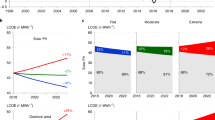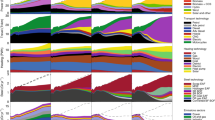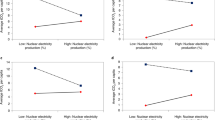Abstract
Substantial renewable energy (RE) cost reductions have raised the prospect of a subsidy-free RE era of the energy transition. The envisaged policy cornerstones of this era are carbon markets, which create economic incentives for sustaining further RE deployment. However, this overlooks that exposing RE to market risks and increasing interest rates would result in substantially higher financing cost, which in turn would lead to much steeper carbon price paths. The resulting political pressure may provoke a price-depressing regulatory intervention, disrupting further RE expansion. Here we conceptualize this feedback and infer indicators for the risk of such an intervention. By quantifying these indicators for the European Union, we find that increased financing cost could double carbon prices in the long term, halve the rate of renewable capacity deployment in the next 15 years and considerably increase the profits of fossil fuel plants. This implies a substantial risk of pushback that policymakers should safeguard against.
This is a preview of subscription content, access via your institution
Access options
Access Nature and 54 other Nature Portfolio journals
Get Nature+, our best-value online-access subscription
$29.99 / 30 days
cancel any time
Subscribe to this journal
Receive 12 digital issues and online access to articles
$119.00 per year
only $9.92 per issue
Buy this article
- Purchase on Springer Link
- Instant access to full article PDF
Prices may be subject to local taxes which are calculated during checkout




Similar content being viewed by others
Code availability
The LIMES-EU model code is available upon request from the authors. Moreover, a process has been started to make the model available under an open-source licence. When this process will be completed, the code will be available for download from the PIK webpage http://pik-potsdam.de/limes.
References
Jansen, M. et al. Offshore wind competitiveness in mature markets without subsidy. Nat. Energy 5, 614–622 (2020).
World Energy Outlook 2020 (International Energy Agency, 2020).
Hall, M. UK government asks how future renewables incentives should work. pv magazine (3 February 2021); https://www.pv-magazine.com/2021/02/03/uk-government-asks-how-future-renewables-incentives-should-work/
Das „3-Säulen-Modell“. Konkretisierung der BDEW-Vorschläge für einen Finanzierungsrahmen für Erneuerbare-Energien-Anlagen (Bundesverband der Energie- und Wasserwirtschaft, 2019); https://www.bdew.de/media/documents/Stn_20190531_Positionspapier-Konkretisierung-des-3-Saeulen-Modells.pdf
Burtraw, D., Palmer, K. & Kahn, D. A symmetric safety valve. Energy Policy 38, 4921–4932 (2010).
Edenhofer, O. et al. Decarbonization and EU ETS Reform: Introducing a Price Floor to drive Low-Carbon Investments (Mercator Research Institute on Global Commons and Climate Change, 2017); https://www.mcc-berlin.net/fileadmin/data/C18_MCC_Publications/Decarbonization_EU_ETS_Reform_Policy_Paper.pdf
Borenstein, S., Bushnell, J., Wolak, F. A. & Zaragoza-Watkins, M. Expecting the unexpected: emissions uncertainty and environmental market design. Am. Econ. Rev. 109, 3953–3977 (2019).
Rabe, B. G. The durability of carbon cap-and-trade policy. Governance 29, 103–119 (2016).
Wettestad, J. & Jevnaker, T. Smokescreen politics? Ratcheting up EU emissions trading in 2017. Rev. Policy Res. 36, 635–659 (2019).
Pierson, P. Increasing returns, path dependence, and the study of politics. Am. Polit. Sci. Rev. 94, 251–267 (2000).
Béland, D. & Schlager, E. Varieties of policy feedback research: looking backward, moving forward. Policy Stud. J. 47, 184–205 (2019).
Skogstad, G. Policy feedback and self-reinforcing and self-undermining processes in EU biofuels policy. J. Eur. Public Policy 24, 21–41 (2017).
Jacobs, A. M. & Weaver, R. K. When policies undo themselves: self-undermining feedback as a source of policy change. Governance 28, 441–457 (2015).
del Río, P. & Mir-Artigues, P. Support for solar PV deployment in Spain: some policy lessons. Renew. Sustain. Energy Rev. 16, 5557–5566 (2012).
Schmid, N., Sewerin, S. & Schmidt, T. S. Explaining advocacy coalition change with policy feedback. Policy Stud. J. 48, 1109–1134 (2020).
Rubin, J. D. A model of intertemporal emission trading, banking, and borrowing. J. Environ. Econ. Manag. 31, 269–286 (1996).
Kling, C. & Rubin, J. Bankable permits for the control of environmental pollution. J. Public Econ. 64, 101–115 (1997).
Meckling, J., Kelsey, N., Biber, E. & Zysman, J. Winning coalitions for climate policy. Science 349, 1170–1171 (2015).
Rozenberg, J., Vogt-Schilb, A. & Hallegatte, S. Instrument choice and stranded assets in the transition to clean capital. J. Environ. Econ. Manage. 100, 102183 (2020).
Cook, B. J. Arenas of power in climate change policymaking. Policy Stud. J. 38, 465–486 (2010).
Salant, S. W. What ails the European Union’s Emissions Trading System? J. Environ. Econ. Manag. 80, 6–19 (2016).
Kitzing, L. Risk implications of renewable support instruments: comparative analysis of feed-in tariffs and premiums using a mean–variance approach. Energy 64, 495–505 (2014).
Kitzing, L. & Weber, C. Support mechanisms for renewables: how risk exposure influences investment incentives. Int. J. Sustain. Energy Plan. Manage. 7, 113–130 (2015).
Tietjen, O., Pahle, M. & Fuss, S. Investment risks in power generation: a comparison of fossil fuel and renewable energy dominated markets. Energy Econ. 58, 174–185 (2016).
Neuhoff, K., May, N. & Richstein, J. Renewable Energy Policy in the Age of Falling Technology Costs. (Deutsches Institut für Wirtschaftsforschung, 2018); https://www.diw.de/documents/publikationen/73/diw_01.c.594384.de/dp1746.pdf
Ostrovnaya, A., Staffell, I., Donovan, C. & Gross, R. The high cost of electricity price uncertainty. SSRN Electron. J. SSRN Working Paper No. 3588288. https://ssrn.com/abstract=3588288 (2020).
Schmidt, T. S. Low-carbon investment risks and de-risking. Nat. Clim. Chang. 4, 237–239 (2014).
Schmidt, T. S. et al. Adverse effects of rising interest rates on sustainable energy transitions. Nat. Sustain. 2, 879–885 (2019).
Grubb, M. et al. Induced innovation in energy technologies and systems: a review of evidence and potential implications for CO2 mitigation. Environ. Res. Lett. 16, 043007 (2021).
Perino, G. New EU ETS Phase 4 rules temporarily puncture waterbed. Nat. Clim. Chang. 8, 262–264 (2018).
Friedrich, M., Fries, S., Pahle, M. & Edenhofer, O. Rules vs. Discretion in Cap-and-Trade Programs: Evidence from the EU Emission Trading System. CESifo Working Paper No. 8637. https://www.cesifo.org/en/publikationen/2020/working-paper/rules-vs-discretion-cap-and-trade-programs-evidence-eu-emission (2020).
Pahle, M. & Schweizerhof, H. Time for tough love: towards gradual risk transfer to renewables in Germany. Econ. Energy Environ. Policy 5, 117–134 (2016).
Egli, F., Steffen, B. & Schmidt, T. S. A dynamic analysis of financing conditions for renewable energy technologies. Nat. Energy 3, 1084–1092 (2018).
Egli, F. Renewable energy investment risk: an investigation of changes over time and the underlying drivers. Energy Policy 140, 111428 (2020).
Kitzing, L., Mitchell, C. & Morthorst, P. E. Renewable energy policies in Europe: converging or diverging? Energy Policy 51, 192–201 (2012).
Stokes, L. C. Short Circuiting Policy: Interest Groups and the Battle Over Clean Energy and Climate Policy in the American States (Oxford Univ. Press, 2020).
Fuss, S. et al. A Framework for assessing the performance of cap-and-trade systems: insights from the European Union Emissions Trading System. Rev. Environ. Econ. Policy 12, 220–241 (2018).
Edenhofer, O., Lessmann, K. & Tahri, I. Asset Pricing and the Carbon Beta of Externalities CESifo Working Paper 9269 (2021).
Nahmmacher, P., Schmid, E., Hirth, L. & Knopf, B. Carpe diem: a novel approach to select representative days for long-term power system modeling. Energy 112, 430–442 (2016).
Osorio, S., Pietzcker, R. C. & Tietjen, O. Documentation of LIMES-EU—A Long-term Electricity System Model for Europe (Potsdam Institute for Climate Impact Research, 2020); https://www.pik-potsdam.de/research/transformation-pathways/models/limes/limes-documentation-april-2020
Zeyringer, M., Price, J., Fais, B., Li, P.-H. & Sharp, E. Designing low-carbon power systems for Great Britain in 2050 that are robust to the spatiotemporal and inter-annual variability of weather. Nat. Energy 3, 395–403 (2018).
Isik, M., Dodder, R. & Kaplan, P. O. Transportation emissions scenarios for New York City under different carbon intensities of electricity and electric vehicle adoption rates. Nat. Energy 6, 92–104 (2021).
Pye, S., Li, F. G. N., Price, J. & Fais, B. Achieving net-zero emissions through the reframing of UK national targets in the post-Paris Agreement era. Nat. Energy 2, 17024 (2017).
E3Modelling. PRIMES Model. Version 2018. Detailed Model Description. https://e3modelling.com/wp-content/uploads/2018/10/The-PRIMES-MODEL-2018.pdf (2018).
Friedrich, M., Mauer, E.-M., Pahle, M. & Tietjen, O. From Fundamentals to Financial Assets: The Evolution of Understanding Price Formation in the EU ETS. ZBW - Leibniz Information Centre for Economics Working Paper. https://www.econstor.eu/handle/10419/216726 (2020).
Hintermann, B. Pass-through of CO2 emission costs to hourly electricity prices in Germany. J. Assoc. Environ. Resour. Econ. 3, 857–891 (2016).
Mosquera-López, S. & Nursimulu, A. Drivers of electricity price dynamics: comparative analysis of spot and futures markets. Energy Policy 126, 76–87 (2019).
Pahle, M. et al. Safeguarding the energy transition against political backlash to carbon markets—figure raw data (Zenodo, 2021); https://doi.org/10.5281/zenodo.5128391
Acknowledgements
This research was conducted as part of the EU’s Horizon 2020 research and innovation programme, project INNOPATHS (grant agreement number 730403, M.P., O.T.), project GREENFIN (European Research Council, grant agreement number 948220, B.S.) and project FFF (German Federal Ministry of Education and Research, grant agreement 01LA1810C, M.P., S.O.). As part of the INNOPATHS project, it was partly supported by the Swiss State Secretariat for Education, Research and Innovation (SERI) under contract number 16.0222 (F.E., B.S., T.S.S.). The opinions expressed and arguments employed herein do not necessarily reflect the official views of the Swiss Government.
Author information
Authors and Affiliations
Contributions
M.P., S.O., O.T., T.S.S., B.S., F.E. and O.E. developed the research idea and the conceptualization. S.O., together with M.P. and O.T., conducted the model analysis. M.P., S.O., O.T., T.S.S., B.S. and F.E. interpreted the results. M.P., together with O.T., B.S., F.E. and T.S.S., wrote the paper. M.P. and T.S.S. secured project funding.
Corresponding author
Ethics declarations
Competing interests
The authors declare no competing interests.
Peer review
Peer review information
Nature Energy thanks Jan Abrell, Jean-Francois Mercure and the other, anonymous, reviewer(s) for their contribution to the peer review of this work.
Additional information
Publisher’s note Springer Nature remains neutral with regard to jurisdictional claims in published maps and institutional affiliations.
Supplementary information
Supplementary Information
Supplementary Notes 1 and 2, Figs. 1 and 2, and Tables 1 and 2.
Rights and permissions
About this article
Cite this article
Pahle, M., Tietjen, O., Osorio, S. et al. Safeguarding the energy transition against political backlash to carbon markets. Nat Energy 7, 290–296 (2022). https://doi.org/10.1038/s41560-022-00984-0
Received:
Accepted:
Published:
Issue Date:
DOI: https://doi.org/10.1038/s41560-022-00984-0
This article is cited by
-
A net-zero target compels a backward induction approach to climate policy
Nature Climate Change (2023)
-
Decarbonization, population disruption and resource inventories in the global energy transition
Nature Communications (2022)



